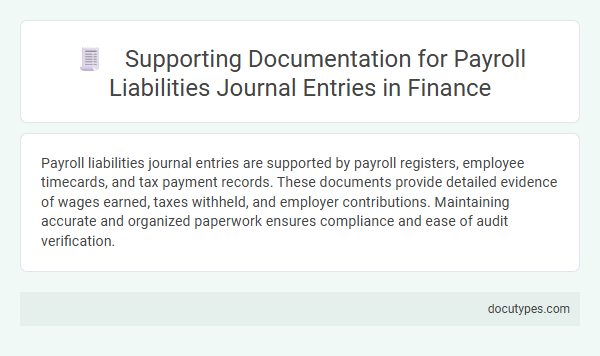Payroll liabilities journal entries are supported by payroll registers, employee timecards, and tax payment records. These documents provide detailed evidence of wages earned, taxes withheld, and employer contributions. Maintaining accurate and organized paperwork ensures compliance and ease of audit verification.
Importance of Supporting Documentation in Payroll Liabilities
| Supporting Documentation for Payroll Liabilities | |
|---|---|
| Payroll Register | Details employee earnings, deductions, and net pay for each payroll period. Serves as primary evidence for payroll liabilities recorded. |
| Timesheets and Attendance Records | Verify hours worked by employees, ensuring accuracy in wages and overtime calculations that impact payroll liabilities. |
| Tax Filings and Reports | Includes federal, state, and local tax returns that confirm payroll tax obligations and payments tied to liabilities on the balance sheet. |
| Benefit and Retirement Plan Statements | Document employer contributions and employee deductions for benefits, supporting corresponding payroll liability entries. |
| Bank and Payment Records | Provide proof of payment for wages, taxes, and benefits, validating reductions in payroll liabilities after disbursement. |
| Importance of Supporting Documentation | |
| Accurate supporting paperwork is essential for verifying payroll liabilities recorded in your financial statements. It ensures compliance with labor laws and tax regulations, reduces the risk of errors, prevents fraud, and facilitates audits. Proper documentation helps maintain transparency, promotes trust with stakeholders, and supports sound financial management of payroll obligations. | |
Key Types of Payroll Liabilities Journal Entries
Payroll liabilities journal entries are supported by various essential documents that ensure accuracy and compliance. Key paperwork includes timesheets, payroll registers, and tax filings that detail employee hours, earnings, and deductions.
These documents verify the amounts owed for wages, taxes, and benefits, reflecting in liabilities such as federal tax withholdings, state unemployment taxes, and employee retirement contributions. Proper documentation aids in reconciling payroll accounts and preparing financial statements with precise liability balances.
Essential Documents Required for Payroll Journal Entries
Accurate payroll journal entries depend on thorough documentation to ensure compliance and financial accuracy. Essential paperwork supports the correct posting of payroll liabilities and helps verify payroll calculations.
- Payroll Register - A detailed record listing gross pay, deductions, and net pay for each employee during the payroll period.
- Tax Withholding Forms - Documents like W-4s and state equivalents that specify employee tax withholding instructions and support liability calculations.
- Benefit and Deduction Authorizations - Agreements and records of employee contributions to benefits, retirement plans, and other deductions that affect payroll liabilities.
Your payroll journal entries must be backed by these documents to maintain accurate financial records and ensure regulatory compliance.
Payroll Registers: Tracking Wages and Deductions
Payroll registers serve as critical documentation that supports journal entries for payroll liabilities by providing detailed records of wages and deductions. You rely on these registers to ensure accuracy in accounting and compliance with financial regulations.
- Comprehensive Wage Tracking - Payroll registers list all employee wages for each pay period, facilitating precise recording of payroll expenses.
- Detailed Deduction Records - These documents itemize deductions such as taxes, benefits, and garnishments, supporting liability accounts and payroll tax calculations.
- Verification for Audits - Payroll registers provide verifiable evidence for auditors, confirming that journal entries match actual payroll transactions.
Timekeeping Records as Payroll Evidence
Timekeeping records serve as crucial evidence supporting journal entries for payroll liabilities by accurately documenting employee hours worked. These records include timesheets, punch cards, and electronic attendance logs, ensuring precise calculation of wages and related payroll obligations. Maintaining detailed timekeeping documentation helps companies verify payroll accuracy and comply with labor regulations.
Tax Forms and Withholding Certificates
What paperwork supports journal entries for payroll liabilities? Tax forms such as Form W-2 and Form 941 provide essential documentation for accurate payroll liability entries. Withholding certificates like Form W-4 verify employee tax withholdings and ensure proper payroll accounting compliance.
Supporting Documentation for Payroll Taxes
Supporting documentation for payroll taxes is essential for accurate journal entries related to payroll liabilities. These documents include payroll tax returns, tax payment receipts, and reports detailing employee tax withholdings.
You should maintain copies of quarterly tax filings such as IRS Form 941, state tax returns, and proof of tax deposits. These records validate the amounts recorded and ensure compliance with tax regulations.
Reconciliation Reports for Payroll Liabilities
Reconciliation reports for payroll liabilities provide crucial support for journal entries by ensuring accuracy between payroll records and accounting ledgers. These reports help verify that all payroll-related expenses and liabilities are properly documented and reflected in financial statements.
- Payroll Register Report - This report summarizes employee earnings, deductions, and employer contributions to confirm payroll expense accuracy.
- Tax Liability Reconciliation - Used to compare payroll tax withholdings and payments against recorded liabilities for compliance verification.
- Benefit Contribution Statements - Documents employer and employee contributions to benefits, supporting related payroll liability entries.
Audit Trails and Payroll Journal Entry Compliance
Payroll liabilities journal entries require supporting paperwork such as payroll registers, employee timecards, and tax withholding documents to ensure accurate record-keeping. Audit trails are essential for tracing payroll transactions back to original documents, verifying compliance with internal controls and regulatory standards. Maintaining thorough documentation safeguards against discrepancies and supports payroll journal entry compliance during financial audits.
What Paperwork Supports Journal Entries for Payroll Liabilities? Infographic

